
Jakarta-Palembang 2011
Aquatics
Aquatics
Aquatics is made up of all sport activities in water (swimming, Water polo, diving and synchronized swimming) this are events that take place in water and have deferent rules.
Swimming: is based on speed in water, there are deferent events like free style, breast stroke, back stroke and butterfly.
The free style races are 50, 100, 200, 400, 800, 1500 and 10 000 meters. The 1500 meters is only for men and the 800 meters is only for women. The breast stroke and the back stroke are 100and 200 meters events the 200 and 400 meters have all four strokes (back stroke, breast stroke, butter fly and free style).
The race is completed by 4 x 100 meter freestyle, 4 x 200 meter freestyle and 4 x 100meter medley relays.
The qualifiers of the preliminary heat in the 50, 100 and 200 meters move to the semi-finals and finals. In the relay and individual events of 400m and above, the eight fastest finishers move directly to the finals, and all the decisions are based on the fastest times.
Water polo: has two post at each end of the pool with a total of thirteen players on each team and only six player and one goal keeper can be in the water at a time from each team.
The men's event are divided into two pools of six for a round-robin preliminary heat, this is for the qualifying teams, the top four from each pool advance to the quarter-finals and the quarter final winners advance to the medal rounds.
The women team play a round-robin preliminary heat, with four teams advancing to the semi finals, and the two teams that fail to qualify, play for the fifth and sixth place.
Diving: is performed from a high platform above a pool and divers hit the water from this high platform with a speed of up to 55km/h.
Points are awarded up to 10 points depending on the elegance and skill. The points are affected by the degree of difficulty. Which is based on the number and times of the maneuvers attempted like surmersult, spikes, tucks and twists. They are judged by a panel of selected judges.
Synchronized swimming: it looks effortless but it is a high demanding sport that requires grace, endurance, flexibility, artistry and an exceptional breath control.
The competitors perform strenuous movement upside down in water with help of a nose clip that makes it difficult for water to enter the nose and allowing the swimmer to stay under water for long period of time.
This sport is open only to women performing to music within a time limit and an underwater speakers to help the competitors when they are underwater to enable them achieve the split second timing critical to synchronize swimming.
Swimmers are judged by panel of judges, they perform specific moves in a set order, including boost, rocket, thrusts and twirls.
List of disciplines
- Diving
- Marathon Swimming
- Swimming
- Synchronized Swimming
- Waterpolo
Diving is closely linked to Gymnastics. Competitors jump head-first into a pool from a three-metre springboard or a 10-metre solid platform.
They perform a series of twists and somersaults before they hit the water.
The aim is to win as many points as possible from a panel of judges who assess each dive for difficulty and style of execution.
As well as individual competitions, there are also Synchronised Diving events, in which pairs of athletes dive in tandem and receive an additional mark for their level of ‘synchronisation’.
List of events
-
men
-
1M SPRINGBOARD
-
3M SPRINGBOARD
-
10M PLATFORM
-
SYNCHRONIZED 3M SPRINGBOARD
-
SYNCHRONIZED 10M PLATFORM
-
-
women
-
1M SPRINGBOARD
-
3M SPRINGBOARD
-
10M PLATFORM
-
SYNCHRONIZED 3M SPRINGBOARD
-
SYNCHRONIZED 10M PLATFORM
-
SYNCHRONIZED 5M PLATFORM
-
-
boys
-
3M SPRINGBOARD
-
10M PLATFORM
-
-
girls
-
3M SPRINGBOARD
-
10M PLATFORM
-
Marathon Swimming is long distance swimming across large bodies of water such as the Great Lakes, the Atlantic Ocean and the English Channel.
Marathon swimming is an endurance sport that pits a swimmer not only against other contenders in the race but also against the currents and tides of the water.
According to International Swimming Federation rules, swimmers cannot use wet suits as this can artificially increase speed or endurance.
Swimmers are accompanied by a nearby boat crew that monitors and advises the competitors.
Marathon swimming has been popularized since Matthew Webb made the first successful crossing of the English Channel in 1875.
Marathon Swimming was incorporated into the Asian Beach Games in 2008.
List of events
-
men
-
5KM
-
10KM
-
-
women
-
5KM
-
10KM
-
Traditional Swimming races take place over distances ranging from 50m to 1500m. Unless it is a Freestyle event, competitors have to use a particular swimming stroke: Breaststroke, Butterfly or Backstroke.
There are also Medley events which combine all three strokes. Olympic races take place in a 50m long pool divided into 10 lanes, with only the middle eight lanes used by swimmers. The swimmer who touches the pool wall first at the end of the race is the winner.
A 10km Open Water race has been added to the Swimming programme for the Beijing 2008 Games. Open Water races are swum outside in areas such as the sea, a lake or a river, and competitors usually swim 2.5km circuits around buoys positioned in the water.
List of events
-
men
-
FREESTYLE, 100M
-
FREESTYLE, 200M
-
FREESTYLE, 400M
-
FREESTYLE, 1500M
-
BACKSTROKE, 50M
-
BACKSTROKE, 100M
-
BACKSTROKE, 200M
-
FREESTYLE, 50M
-
BREASTSTROKE, 50M
-
BREASTSTROKE, 100M
-
BREASTSTROKE, 200M
-
BUTTERFLY, 100M
-
BUTTERFLY, 200M
-
INDIVIDUAL MEDLEY, 200M
-
INDIVIDUAL MEDLEY, 400M
-
FREESTYLE RELAY, 4X200M
-
MEDLEY RELAY, 4X100M
-
BUTTERFLY, 50M
-
INDIVIDUAL MEDLEY, 100M
-
FREESTYLE RELAY, 4X50M
-
FREESTYLE RELAY, 4X100M
-
MEDLEY RELAY, 4X50M
-
FREESTYLE, 800M
-
-
women
-
BACKSTROKE, 200M
-
FREESTYLE, 50M
-
FREESTYLE, 100M
-
FREESTYLE, 200M
-
FREESTYLE, 400M
-
FREESTYLE, 800M
-
BACKSTROKE, 50M
-
BACKSTROKE, 100M
-
BREASTSTROKE, 50M
-
BREASTSTROKE, 100M
-
BREASTSTROKE, 200M
-
BUTTERFLY, 50M
-
BUTTERFLY, 100M
-
BUTTERFLY, 200M
-
INDIVIDUAL MEDLEY, 200M
-
INDIVIDUAL MEDLEY, 400M
-
FREESTYLE RELAY, 4X100M
-
FREESTYLE RELAY, 4X200M
-
MEDLEY RELAY, 4X100M
-
INDIVIDUAL MEDLEY, 100M
-
FREESTYLE RELAY, 4X50M
-
MEDLEY RELAY, 4X50M
-
FREESTYLE, 1500M
-
-
boys
-
FREESTYLE, 50M
-
BACKSTROKE, 100M
-
BREASTSTROKE, 100M
-
BUTTERFLY, 100M
-
FREESTYLE, 100M
-
BACKSTROKE, 200M
-
BREASTSTROKE, 200M
-
BUTTERFLY, 200M
-
FREESTYLE, 200M
-
INDIVIDUAL MEDLEY, 200M
-
FREESTYLE, 400M
-
FREESTYLE RELAY, 4X100M
-
MEDLEY RELAY, 4X100M
-
BACKSTROKE, 50M
-
BREASTSTROKE, 50M
-
BUTTERFLY, 50M
-
-
girls
-
FREESTYLE, 50M
-
BACKSTROKE, 100M
-
BREASTSTROKE, 100M
-
BUTTERFLY, 100M
-
FREESTYLE, 100M
-
BACKSTROKE, 200M
-
BREASTSTROKE, 200M
-
BUTTERFLY, 200M
-
FREESTYLE, 200M
-
INDIVIDUAL MEDLEY, 200M
-
FREESTYLE, 400M
-
FREESTYLE RELAY, 4X100M
-
MEDLEY RELAY, 4X100M
-
BACKSTROKE, 50M
-
BREASTSTROKE, 50M
-
BUTTERFLY, 50M
-
-
mixed
-
MIXED MEDLEY RELAY, 4X100M
-
Synchronised Swimming is for women only. It is sometimes called ‘water ballet’, as competitors perform short routines to music in the pool. Routines are judged on technical merit and artistic impression.
There are two events: Duet (for pairs) and Team (for groups of eight). In each, the winner is the one who gets the most points from the judges based on how well they perform the moves, and how well the routine is put together.
List of events
-
women
-
TEAM
-
DUET
-
FREE COMBINATION
-
SOLO
-
Water polo is a team water game. A team consists of six field players and one goalkeeper. The winner of the game is the team that scores more goals.
Water polo was developed in Europe and the United States as two separate sports. In the United States it was termed softball water polo, with the ball being an unfilled bladder.
The sport was very rough, often degenerating into numerous fights. In 1897, Harold Reeder of New York formulated the first American rules for the discipline, which were aimed at decreasing the excessive roughness of the game.
The game is called water polo because players initially rode on floating barrels that resembled mock horses, and swung at the ball with mallet-like sticks, similar to those used in equestrian polo.
Ultimately, the European style of water polo predominated and today it is the form of the game practised universally.
It is more scientific, faster and less dangerous than the original American game. The current game consists of seven-man teams playing four seven-minute periods.
List of events
-
men
-
TEAM
-
-
women
-
TEAM
-
Related links
Sports Committee
The Sports Committee consist of one Chairman and a minimum of five members. The Chairman, nominated by his NOC, will be elected by the GA, while the Members preferably representing the 5 zones of t...
Sports and Environment Committee
The Sports and Environment Committee consist of One Chairman and Five Members. The Chairman, nominated by his NOC, will be elected by the GA, while the Members preferably representing the 5 zones o...
Sports for All Committee
The Sports for All Committee shall consist of One Chairman and Five Members. The Chairman, nominated by his NOC, will be elected by the GA, while the Members preferably representing the 5 zones of ...
Sports Federations
-

Asian Federation
Asia Swimming Federation
-

International Federation
World Aquatics
